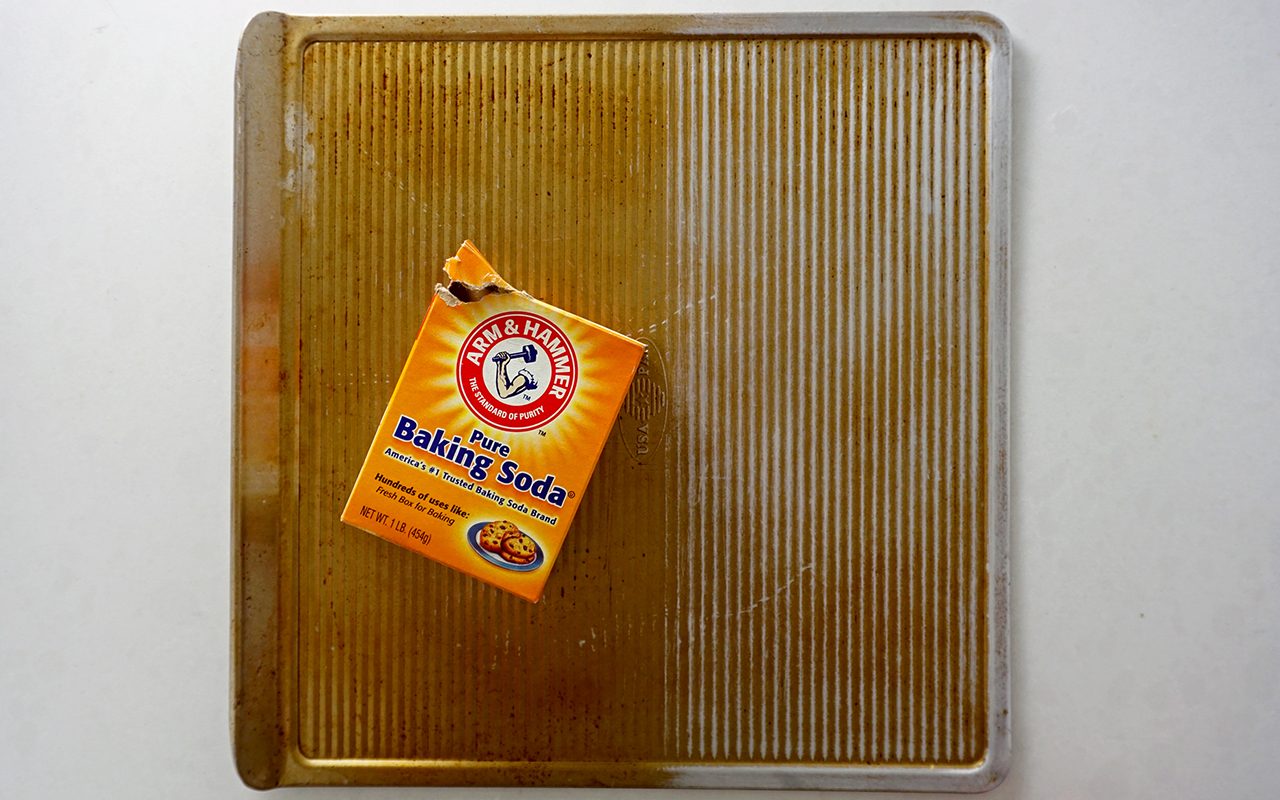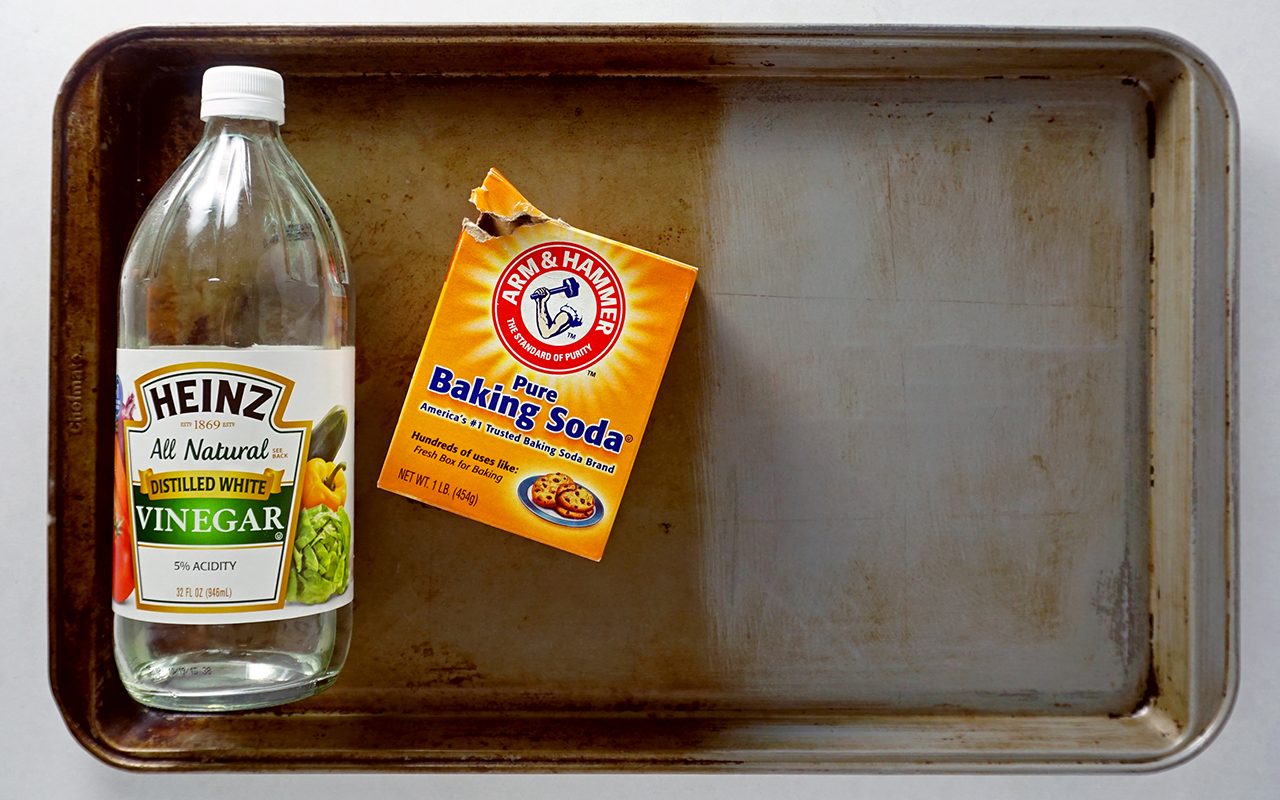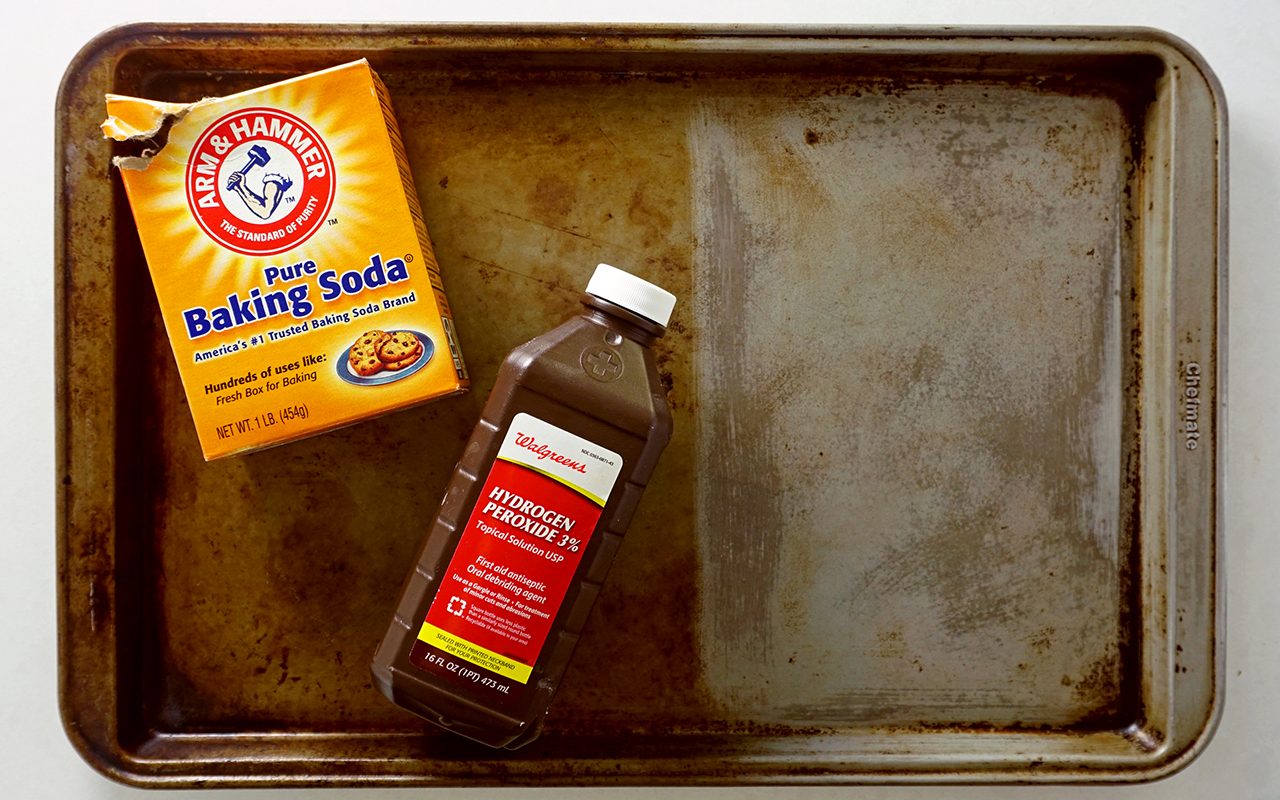“Put your back into it!”
This is a phrase that should only be heard if you’re in the midst of training for an upcoming Strongman Competition. But if a family member is yelling this at you while you’re cleaning baking sheets, well, then you’re working too hard. Don’t feel bad, though. Like us, you may have forgotten the original color of your well-used baking sheets. What was once shiny and bright is now a mottled blend of black and brown that you have accepted as your pan’s new look.
But there are ways to breathe scrub new life into your baking sheets! We put four of the most popular cleaning techniques to the test on some dirty baking sheets to see which method was truly up to the challenge.
Keep reading as we explain how each method works, along with our results.
How We Tested Each Cleaning Method
In cleaning baking sheets, we wanted to have some semblance of a scientific method. Therefore, we not only tested each cleaning method on an individual baking sheet but also divided a single pan into fourths to test the techniques side-by-side. This allowed us to test each method on a pan from a single brand, made out of the same material/coating and with a common mess cooked into the surface. For testing purposes, we also limited scrubbing time to 15 minutes for each method.
Results were then rated on a scale of one to five. Ratings were awarded based on how long each technique took, how much extra elbow grease was required and the overall ease or difficulty of the cleaning process.
Warning: Before cleaning your pans with any one of these methods, test it on a small, inconspicuous portion of your baking pans to ensure they don’t damage the surface of your pans.
Cleaning Baking Sheets with Baking Soda + Water

Time: 30 minutes of soaking and 15 minutes of scrubbing
Rating: 3/5
Process: In a small bowl, make a paste out of baking soda and a few tablespoons of clean water. Spread the paste onto the pan and let it sit on the surface of the baking sheet for 30 minutes. Then, scrub away using a nylon pad, sponge or brush until clean. Give the pan a final wash using dish soap and warm water.
Results: This method took the least amount of time to see results but also required the most elbow grease. This is probably because baking soda alone is not as caustic as a solution paired with an acid like vinegar or hydrogen peroxide. After 15 minutes of scrubbing, there was a visible improvement on the baking sheets we tested but deep, set-in stains were still present. This method may be best for pans with lighter staining or nonstick pans since more abrasive solutions may damage the coating.
Cleaning Baking Sheets with Baking Soda + White Vinegar

Time: 60 minutes of soaking and 15+ minutes of scrubbing
Rating: 4/5
Process: Measure out a 1:1 ratio of baking soda to white vinegar, about 1/4 cup of each. Then, sprinkle the baking soda over the dirty pan and pour the vinegar over the surface. Let the two products begin to react. Meanwhile, fill a sink with hot, clean water. Submerge the pan in the hot water and let it soak for 30-60 minutes. After soaking, use a nylon pad or steel wool to scrub away the grime. Wash again using dish soap and warm water, rinse and dry.
Results: This method really worked well. After a 60-minute soak in hot water and 15 minutes of scrubbing, nearly all the stains and grime were removed. The only reason we docked a point is we did need to use considerable scrubbing power to get the heaviest stains to lift. With that being said, we do think another 3-5 minutes of scrubbing would have probably lifted the remaining stains completely.
Cleaning Baking Sheets with Hydrogen Peroxide

Time: 6 hours of soaking and 15 minutes of scrubbing
Rating: 2/5
Process: While wearing rubber gloves, soak a damp paper towel or dishcloth with hydrogen peroxide. Rub the cloth gently over the surface of the baking pan to saturate the surface, then lay the cloth flat over the pan to cover it. If you’re working on a large pan, you may need to use multiple paper towels or dishcloths to cover the entire surface. Let the pan sit for at least 2 hours or up to 8 hours for really tough messes. Then, remove the cloth and scrub the pan in hot water using a scouring pad to lift remaining stains. Wash thoroughly with dish soap and rinse in clean water.
Results: Similar to baking soda alone, hydrogen peroxide on its own doesn’t quite have the punch it needs to lift heavy food stains. This method lost points because it not only lacks potency but also took a lot of time to soak. We will say that light stains lifted easier with this method than those involving baking soda solutions. However, once those light stains were gone it didn’t have much impact on the deeper stains.
Cleaning Baking Sheets with Baking Soda + Hydrogen Peroxide

Time: 6 hours of soaking and 15 minutes of scrubbing
Rating: 4/5
Process: Using a 1:1 ratio of baking soda and hydrogen peroxide, form a paste by mixing the two together in a small bowl. Spread the paste evenly over the surface of the baking sheet. Let the paste sit on the pan for at least 2 hours or up to 8 hours for bigger messes. After time has elapsed, wipe away the mixture from the baking pans using a paper towel and water. Scrub any remaining residue away using a nylon pad, sponge or brush and then give the pan a final wash with dish soap and hot water to thoroughly clean.
Results: This method was just about as effective as the baking soda and vinegar solution. While the vinegar-based solution lost a point because it required heavier scrubbing, this method loses a point because of how much time it requires. Stains lifted easily with this method, requiring only a light hand to scrub. However, those results were only possible due to the longer soaking time, which may not always be convenient.
Final Thoughts
Overall, all four methods were effective at lifting grime and giving new life to the baking sheets. While none of the methods received a perfect score, we still think each method has its merits depending on how much time you’re willing to invest. Ultimately, it comes down to investing either time or effort.
Personally, we’ll stick with a baking soda and vinegar solution to deep-clean our baking sheets if we’re short on time, and reserve a baking soda and hydrogen peroxide solution for big messes that require extra time to lift set-in stains.
Warning: If, after reading this, you’re wondering why we also didn’t try a solution combining baking soda, vinegar AND hydrogen peroxide, it’s because that combination is dangerous. When mixed together, vinegar and hydrogen peroxide create what’s called peracetic acid, which is potentially toxic and can irritate the skin, eyes and respiratory system.
Now that your baking pans are clean as a whistle, there’s only one thing to do: make ’em dirty again. Use your clean pans to roast these tasty sheet pan dinners!

Santa Fe Chicken Pizza Pie
Give your pie a Southwest twist when you slather on the taco sauce and top with black beans, green chilies and kicked-up chicken strips. —Taste of Home Test Kitchen, Milwaukee, Wisconsin
Sliced Ham with Roasted Vegetables
To prepare this colorful, zesty oven meal, I "shop" in my backyard for the fresh garden vegetables and oranges (we have our own tree!) that spark the ham's hearty flavor. It's my family's favorite main dish. —Margaret Pache, Mesa, Arizona
Chicken Veggie Fajitas
Our family loves the spicy flavor of these fajitas. I also appreciate the fact that they’re fast to fix. —Eleanor Martens, Rosenort, Manitoba
Turkey Lattice Pie
With its pretty lattice crust, this cheesy baked dish looks as good as it tastes. It's easy to make, too, since it uses ready-to-go crescent roll dough. —Lorraine Naig, Emmetsburg, Iowa
Pork and Asparagus Sheet-Pan Dinner
When time is of the essence, it's nice to have a quick and easy meal idea in your back pocket. Not only is it delicious, but you can clean it up in a flash. —Joan Hallford, North Richland Hills, Texas
Chili-Stuffed Poblano Peppers
While exploring Mexican restaurants, I tasted chiles rellenos and wanted to make them at home. My husband and I teamed up to create this new favorite recipe, stuffed poblano peppers. —Lorrie Grabczynski, Commerce Township, Michigan
Sheet-Pan Pineapple Chicken Fajitas
I combined chicken and pineapple for a different flavor on our fajitas. It's more on the sweet side but my family loved them! —Nancy Heishman, Las Vegas, Nevada
Sheet-Pan Tilapia and Vegetable Medley
Unlike some one-pan dinners that require some precooking in a skillet or pot, this one, with fish and spring veggies, uses just the sheet pan, period. —Judy Batson, Tampa, Florida
Fish and Fries
For an awesome crunch and golden color without deep frying, we coat fish with cornflake crumbs and bake it. Try it with homemade french fries for a fun spin on fish and chips. —Janice Mitchell, Aurora, Colorado
Sheet-Pan Chipotle-Lime Shrimp Bake
I like to make this seafood dinner for company because it tastes amazing, but takes very little effort to throw together. Use asparagus, Broccolini or a mix of the two. It’s all about what's available for a decent price. —Colleen Delawder, Herndon, Virginia
Lemon-Dijon Pork Sheet-Pan Supper
Most nights, I need something that I can get on the table with minimal effort and delicious results. This sheet-pan supper has become an all-time favorite, not only because of its bright flavors, but its speedy cleanup time, too! —Elisabeth Larsen, Pleasant Grove, Utah
Cod and Asparagus Bake
In this bright and lively one-pan dish, green and red veggies back up tender fish, and lemon pulls everything together. You can use grated Parmesan cheese instead of Romano. —Thomas Faglon, Somerset, New Jersey
Spicy Roasted Sausage, Potatoes and Peppers
I love to share my cooking, and this hearty meal-in-one has gotten a savory reputation around town. People have actually approached me in public to ask for the recipe. —Laurie Sledge, Brandon, Mississippi
Pepperoni Pan Pizza
I've spent years trying to come up with the perfect pizza crust and sauce, and they're paired up in this recipe. I fix this crispy, savory pizza for my family often, and it really satisfies my husband and sons. —Susan Lindahl, Alford, Florida
Crumb-Topped Salmon
Often we catch enough of our delicious Northwest salmon to send some to Michigan for my sister to enjoy. This crisp, lemony recipe is a tasty way to enjoy it. —Perlene Hoekema, Lynden, Washington
Puff Pastry Chicken Bundles
Inside these golden puff pastry "packages", chicken breasts rolled with spinach, herbed cream cheese and walnuts are a savory surprise. I like to serve this elegant entree when we have guests or are celebrating a holiday or special occasion. -Brad Moritz, Limerick, Pennsylvania
Buffalo Chicken Pizza
Fans of spicy chicken wings will love this rendition that turns it into pizza. Serve it up with blue cheese dressing and crisp celery, just like the tasty original. —Shari DiGirolamo, Newton, Pennsylvania
Horseradish-Crusted Turkey Tenderloins
Looking for a low-carb entree ideal for company? Consider this specialty. It won a local recipe contest and was featured on a restaurant's menu. The creamy sauce adds a flavor punch. —Ellen Cross, Hubbardsville, New York
Mediterranean Tilapia
I recently became a fan of tilapia. The mild taste makes it easy to top with our favorite ingredients. And it’s low in calories and fat. What’s not to love? —Robin Brenneman, Hilliard, Ohio
Breadstick Pizza
Not only do refrigerated breadsticks lend a fun twist to pizza, but they make this dish a weeknight staple at my house. Feeding kids? Slice pieces into small strips and let the kids dip each strip into marinara sauce. They’ll love it! —Mary Hankins, Kansas City, Missouri
Roasted Kielbasa & Vegetables
I like this dish featuring kielbasa and veggies for two reasons: It's so hearty, and it’s a one-pan meal. That’s a win-win dinner! —Marietta Slater, Justin, Texas
Hoisin & Honey Glazed Salmon
Now that I have this recipe, my husband and I always look forward to the fresh wild salmon season. You can find hoisin sauce in the international foods aisle at the grocery store. —Cheryl Rein, Orlando, Florida
Spicy Apricot-Glazed Chicken
Save yourself a trip to the store and check the fridge first. Chicken turns sweet and hot when you pull out the chili sauce, mustard and apricot preserves. —Sonya Labbe, West Hollywood, California
Avocado Crab Boats
These boats are wonderful with tortilla chips, beans or rice. You can also cover them, pack them on ice, and take them to a picnic or potluck. Straight from the oven or cold, they're always delicious. —Frances Benthin, Scio, Oregon
Sweet & Tangy Salmon with Green Beans
I'm always up for new ways to cook salmon. In this dish, a sweet sauce gives the fish and green beans some down-home barbecue tang. Even our kids love it. —Aliesha Caldwell, Robersonville, North Carolina
Parmesan Chicken with Artichoke Hearts
I've liked the chicken and artichoke combo for a long time. Here's my own lemony twist. With all the praise it gets, this dinner is so much fun to serve. —Carly Giles, Hoquiam, Washington
Pan-Roasted Chicken and Vegetables
This one-dish roast chicken with vegetables tastes as if it took hours of hands-on time to put together, but the simple ingredients can be prepped in mere minutes. The rosemary gives it a rich flavor, and the meat juices cook the veggies to perfection. It’s unbelievably easy! —Sherri Melotik, Oak Creek, Wisconsin
Pan-Roasted Pork Chops & Potatoes
A shortcut marinade gives these chops plenty of flavor, and the crumb coating packs on the crunch. For color, I like to tuck in a few handfuls of Brussels sprouts. —Char Ouellette, Colton, Oregon
Salmon with Horseradish Pistachio Crust
Impress everyone at your table with this elegant but easy salmon that's delicious and nutritious. You can substitute scallions for shallots if you like. —Linda Press Wolfe, Cross River, New York
Sheet-Pan Chicken Parmesan
Saucy chicken, melty mozzarella and crisp-tender broccoli, all in one pan. What could be better? —Becky Hardin, St. Peters, Missouri
Crispy Dill Tilapia
Every week I try to serve a new healthy fish. With its fresh dill and delicious panko bread crumb herb crust, this dish with mild tilapia is a winner. —Tamara Huron, New Market, Alabama
Tex-Mex Chicken Strips
I was looking for a way to amp up the flavor of regular chicken strips so I crushed up some leftover corn chips to create a crispy, flavorful coating. —Cynthia Gerken, Naples, Florida
Bacon, Lettuce and Tomato Pizza
I bring together two all-time favorites with this recipe: pizza and BLT sandwiches. I brought this fun mashup to a ladies lunch and was met with "oohs" and "ahhs." —Bonnie Hawkins, Elkhorn, WisconsinThe post We Tried 4 Methods for Cleaning Baking Sheets and Found the Best appeared first on Taste of Home.
Lauren Habermehl